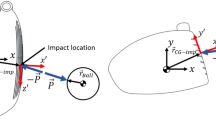Abstract
To model the impact dynamics of a golf drive, finite element (FE) models of the ball and the clubhead are created and combined to simulate the collision of the two bodies. A three-piece golf ball is modelled using only solid elements, while the clubhead is modelled using solid elements for the crucial area of the impact, i.e. the clubface, and using shell elements for the rest of the clubhead to improve the computational efficiency of the simulation. The correct transfer of forces and moments in the transition area between the shell and solid elements is assured by introducing kinematic nodal constraints using rigid elements. The FE model is used to optimize the shape of the clubface in three steps to maximize the launch velocity of the golf ball for central impacts. A final clubface shape is reached and a total improvement of 4.8 m/s over the initial design is obtained. This is a 7% gain in launch velocity, which results in a driving length advantage of approximately 20 m (or 22 yards) until the first contact with the ground. During the optimization process, the mechanical impedances of the two colliding bodies were recorded and compared. It is shown that the optimal clubhead geometry does not agree with the impedance matching theory by comparing the optimization results to those obtained from a simple lumped parameter model.














Similar content being viewed by others
References
Bathe KJ, Wilson EL (1976) Numerical methods in finite element analysis. Prentice-Hall, Englewood Cliffs
Beach T, Anderson D, Vincent B (2007) Golf clubhead. U.S. Patent number 7,198,575
Cochran A, Stobbs J (2005) Search for the perfect swing, 2nd edn. Triumph Books, Chicago
Holzapfel GA (2000) Nonlinear solid mechanics: a continuum approach for engineering. Wiley, New York
Nakai K, Wu Z, Sogabe Y, Arimitsu Y (2004) A study of thickness optimization of golf clubheads to maximize release velocity of balls. In: Communications in numerical methods in engineering, vol 20. Wiley, New York, pp 747–755
Petersen W, McPhee J (2008) Comparison of impulse-momentum and finite element models for impact between golf ball and clubhead. In: Science and Golf V: proceedings of the World Scientific Congress of Golf, Phoenix
Petersen W, Sahelian A, McPhee J (2009) Comparison of golf ball/driver impact models with respect to mechanical impedance matching. In: Proceeding of ASME conference on smart materials, adaptive structures and intelligent systems SMASIS, Oxnard
Tanaka K, Sato F, Oodaira H, Teranishi Y, Sato F, Ujihashi S (2006) Construction of finite-element models of golf balls and simulations of their collisions. In: Proceedings of the institution of mechanical engineers, part L. J Mater Des Appl 220:13–22
Yamaguchi T, Iwatsubo T (1998) Optimum design of golf club considering the mechanical impedance matching. In: Science and golf III: proceeding of the World Scientific Congress of Golf, St Andrews
Acknowledgment
The authors would like to thank Dr Tom Mase, who kindly provided a baseline CAD model of a generic clubhead with constant thickness face.
Author information
Authors and Affiliations
Corresponding author
Rights and permissions
About this article
Cite this article
Petersen, W., McPhee, J. Shape optimization of golf clubface using finite element impact models. Sports Eng 12, 77–85 (2009). https://doi.org/10.1007/s12283-009-0030-7
Published:
Issue Date:
DOI: https://doi.org/10.1007/s12283-009-0030-7




